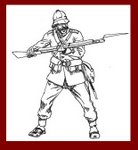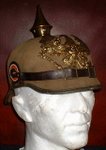Soldier's Companion Design Notes
MY INTENT in designing these rules was fairly simple. I wanted a good, workmanlike set of colonial, 19thcentury rules to which the science fiction aspect of Space: 1889 could be grafted. That particular order of things is important. The colonial rules come first, not the weird science. A number of our playtest games were fought with no mechanical conveyances at all, and one was even a Northwest Fronner battle between Brits and Pathans.
Having said that, it should also be obvious that the rough framework upon which the game was built was Sky Galleons of Mars. These rules are almost 100-percent compatible with that boargame, and it is a very simple matter to use Geohex terrain tiles for the miniatures terrain and treat those 12" hexes as equivalent to a single hex on the Sky Galleons map. If you want, you can even use this mega-grid to move and turn your ships; it produces the same results as the miniatures game movement rules.
My next goal was to remain as faithful to the 19th century as possible. The sidebar quotations from articles are not invented; all are authendlc. All units mentioned in this book (with the obvious exception of those raised on Mars, Venus, or the Moon) are real, to the best of my ability to ascertain. Even that unlikely unit of "Amazonians," Company A, 62nd St. John Fusiliers of New Brunswick, Canada was a genuine militia unit, and for a photograph of the company in uniform (including the male company commander in the regiment's mess jacket) see plate 127 of Haythornthwaite's Victorian Colonial Wars.
Likewise, all British commanders of army units mentioned in the various orders of battle, along with their military records, are authentic, with the obvious exception, again, of service on Mars or Venus. The parenthetical comments on their characters and abilities are, however, completely fabricated, and some have been made "plodders" for game interest rather than as a result of their actual abilities or performances. In that sense, this does not pretend to be history, and no criticism of men who served with unblemished records is intended.
Players interested in additional readings in this era are directed to the bibliography on page 167. I am certain that I have neglected several books consulted along the way, but the majority of sources are there.
There are several mechanics worth discussing briefly. One, of course, is figure scale. Since we have small companies in the game and only four companies per battalion instead of eight or more, it's obvious we've scaled things down a bit. There is no precise figure scale, but there end up being about 80 men to a battalion that usually fielded upward of 800, so 10:1 is as good a rule of thumb as any. Where I have specified the size of various native armies in Africa, it is based on this 10:1 rule.
One rating that I am quite happy with is the Fieldcraft skill, which I originally encountered in a set of rules by Greg Novak on German colonial warfare in southwest Africa. Although I have played around a bit with how it is used, the basic concept was his, and I think that it's a good one and is very useful in differentiating troop types and capabilities.
One important mechanic in the game is the use of hits as a modifier to morale instead of casualties, an idea first saw used by Hal Thinglum in his very entertaining Rourke's Drift miniatures game. This rule, along with the saving throw rule on small arms fire, enabled me to put together a game where there could be a lot of firing and a lot of game results (checks, shaken morale, and so forth) but relatively few casualties. Of course, there can be a lot of casualties if you are formed in the open, but in a skirmish through broken ground the effects of firepower will be more morale-centered than casualty-centered.
My playtesters made me promise to include some advice on how to play irregulars. It isn't easy in this game, as regulars have numerous advantages. I can make a few suggestions, however.
First, take a look at how the actual irregular armies fought and whether or not they were successful. The Zulus had a very useful technique, for instance. They would have their reserve troops in a battle sit down on the ground with their backs to the enemy. If they could not see the course of the battle, they would not become frenzied and carry out a premature charge. This is a useful way of avoiding the witness-to-victory morale test. In the game this can be accomplished by judicious placement of troops.
Second, getting the initiative can be a real problem. Try to leave yourself with a means to seize the initiative at a critical moment, which is to say, try to keep at least one unit hidden but in a position where it can see the enemy. If in such a position, it can launch a charge from hiding and guarantee you the initiative for one turn.
Next, regular human troops tend to have tremendous firepower, particularly if armed with bolt-action rifles, so don't give them targets just for the heck of it. In one game a small village had a few regulars defending it who were spread around the village's perimeter. When the natives charged, they did so from every side, thus guaranteeing that every defender was able to fire. It is better to hit the defenses from one side with all of your strength.
If you have a good Fieldcraft, use it. Keep in open order in cover and snipe at the nice redcoats standing there in close order formation.
Let me close with a piece of general advice to players and referees alike. Miniatures gaming is a form of entertainment, and these rules are intended to provide you with the means of putting on an entertalnlng game. It is foolish, then, to let the printed rules stand in the way of your enjoyment. The bulk of this book should serve as testimony to the effort put into making it as complete as it can be, but a set of rules is sterile without an active set of players. If you disagree with anything in these rules, please feel free to modify it to suit your own tastes. Just don't argue about it while the game is being played. During the game, the referee's word is absolute law, above even the printed words of the rules.































5 comments:
If you have a good Fieldcraft, use it. Keep in open order in cover and snipe at the nice redcoats standing there in close order formation.
*******************************
LOL, remember that one Joe...mass
formation into an artillery battery
is never a good idea! ;-P
LOL, I do remember that game, very nasty effects gape shot Vs hide shields...;-)
Yeah, I didn't use the terrain
on that one, I was hoping to
just blow through the guns with initiative and numbers.......lesson learned!
joe said...
.......lesson learned!
Especially when you are attacking a career artilleryman in a fortified position....)
Bill said...Especially when you are attacking a career artilleryman in a fortified position....)
Wrath of the gunbunny.... ;-)
Post a Comment